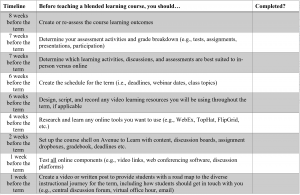Ten Facts You Need to Know About Blended Learning
3 How Do I Go About Making the Transition?
Offering a blended learning course requires extensive work upfront for it to run smoothly. But even the most prepared instructor will face bumps throughout the term and will learn lessons that can be implemented in future iterations of the course.
Achieving the goals of blended learning can be realized by following these 10 Guidelines to Online Learning from Stanford University when it comes to the online components.
Ten Best Practices for Teaching Online
| Best practice 1 | Be present at the course site. |
| Best practice 2 | Create a supportive online course community. |
| Best practice 3 | Develop a set of explicit expectations for your learners and yourself as to how you will communicate and how much time students should be working on the course each week. |
| Best practice 4 | Use a variety of large group, small group, and individual work experiences. |
| Best practice 5 | Use synchronous and asynchronous activities. |
| Best practice 6 | Ask for informal feedback early in the term. |
| Best practice 7 | Prepare discussion posts that invite responses, questions, discussions, and reflections. |
| Best practice 8 | Search out and use content resources that are available in digital format if possible. |
| Best practice 9 | Combine core concept learning with customized and personalized learning. |
| Best practice 10 | Plan a good closing and wrap activity for the course. |
A link to a detailed description of these guidelines is found in the Resources and Support Section of this document.
Design of any course (online and face-to-face components) should ideally follow the Instructional Design System used in organizations – the same one we teach our students. The six steps are:
- Needs Assessment – who, what, and why
- Ensuring readiness for training/learning – attitude, motivation, support
- Creating a learning environment that includes clear learning objectives, meaningful content, practice and feedback, observation and interaction with others, administration and coordination, memory retention
- Ensuring transfer of training/learning – self-management, peer and instructor support
- Selecting training/learning activities – presentation, hands-on, group
- Evaluating learning – knowledge, comprehension, application, and so on.
Here are some questions to consider while preparing to teach a blended learning course:
- What knowledge and skills do you want students to have when they finish your class? How will you encourage and assess this?
- Do you anticipate the same population of students that would enroll in a face-to-face class? If the students tend to be older or have more experience, how will you leverage these differences?
- Which tools do you want to use for the online portion (e.g., Avenue discussion boards, Google Docs/Sheets/Slides, Flipgrid or WebEx video conferences) and the face-to-face portion (e.g., TopHat or PollEverywhere for live polling)?
- What digital assets do you need to create before the class begins (e.g., instructional videos, PDFs, blog posts)?
- Is there any training that students and your teaching assistants will need to receive on digital tools, course policies, etc.?
We strongly recommend that you do NOT try to do too much your first-time around. Introducing one new technology per term is a good way to start. For some, using existing tools on Avenue to Learn such as Links, Discussions, and Resources may be the place to start. If you have had some experience with online tools, this may be your opportunity to add a new tool.
Here is a more specific timeline for preparing a blended learning course. In Appendix 3 you will find a rubric for evaluating online components.

In Appendices 3 and 4, you will find detailed criteria for designing and delivering online courses that will be helpful as you move through the transition process to anticipate new demands and to fix any existing gaps in terms of course design and delivery. These criteria were taken from detailed rubrics presented in a report to the Ontario Council of Universities entitled Quality Standards for the Delivery of High-Quality Online Courses. You will see that many of the items can be applied to traditional face-to-face courses as well as to online or blended learning courses.
